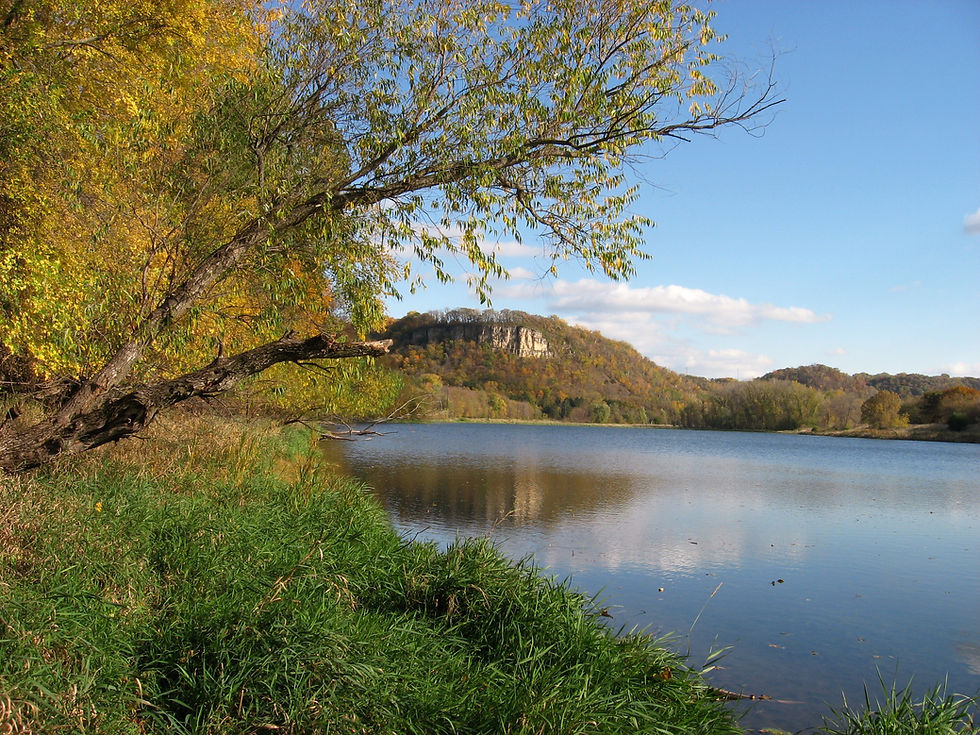Fall Colors and Pelican Surprises
- Bruce Ause
- Oct 23, 2017
- 3 min read

Wacouta Fall Colors
According to the Minnesota DNR website on October 20th, leaf color changes in Goodhue County were at about 50%. This seems to be about one week later than normal. I'm guessing this is partly due to the fact we have yet to experience a killing frost. The bluff photo featured here was taken from the summit of Rattlesnake Bluff and is located across Highway 61 from Wacouta Pond.

Juvenile White Pelican
It has been my experience in recent years that as long as the fall river level stays fairly low (between 4 and 6 feet), the feeding conditions for white pelicans are conducive for them to stick around until early November. So with the Mississippi River levels the past couple weeks approaching 10 feet and waterfowl hunting season taking place, I was quite surprised while paddling my canoe in the morning of October 18th to observe at least 100 pelicans actively feeding in Wacouta Bay at the Head of Lake Pepin. What was most unusual was they were feeding in and along the edge of the flooded lowland forest. They are not very well adapted for flying in and among the trees.

Feeding Pelican
Unlike brown pelicans that plunge dive to catch fish, white pelicans feed from the water's surface, dipping their beaks into the water to catch fish or other aquatic organisms. They often can be seen upended like a large dabbling duck.

Pelicans and Double-Crested Cormorants
White pelicans with a wingspan of 8 to 9 feet are the largest birds to live in Minnesota. To give you an idea of how large they are, here is a photo of pelicans co-habitating on a dead floating tree with a group of double-crested cormorants.

Muskrat House
Another unexpected recent observation was the discovery of a fresh muskrat house on the west end of Wacouta Pond. I cannot recall how many years it has been since making such an observation. One reason for this is the lack of emergent aquatic vegetation necessary for constructing living quarters.

Wild Turkeys
With the abundant mast crop production this fall, now is the time to observe wild turkeys and deer feasting on all the available acorns.

Milkweed Seeds
A recent observation along the Rattlesnake Bluff Trail has been the opening up and casting forth of seeds from the common milkweed. In World War II, milkweed down was often the only thing that kept a downed aviator or soaking wet sailor from slipping under the waves. This material was used as an all-important filler for flotation devices after the supply of Asian kapok was cut off from southeast Asia.

Horse Nettle Fruit
I recently came upon a colorful and most unusual fruit as I was on an early morning hike. These fruits look a little like ground cherries without the husks. Horse nettle is not a nettle, but rather a member of the nightshade family. These fruits are poisonous to humans, but are eaten by pheasants and wild turkeys.

View of Pleasant Valley Lakelet
On October 7th, I was asked to lead a hike for a group of nearly 50 members of the Minnesota Parks And Trails Council to the top of a bluff overlooking Pleasant Valley Lakelet near Frontenac Station. The occasion was an open house celebrating the recent purchase of an 160 acre farm adjacent to Frontenac State Park by the Parks and Trails Council. Long range goals would be that this might be an incredible addition to the existing park.




Comments